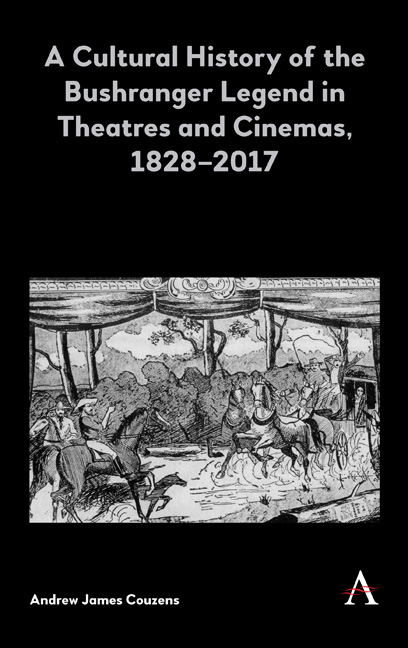Book contents
- Frontmatter
- Contents
- List of Figures
- Acknowledgements
- Introduction: Defining the Bushranger Legend
- Part 1 Establishing the Legend
- Part 2 Developing the Legend
- 5 The Bushranger Genre from Stage to Screen
- 6 The Bushranger Ban
- 7 British and American Interventions in the Bushranger Legend
- 8 Radical Nationalism and the Bushranger Legend
- Part 3 Fragmenting the Legend
- Conclusion
- Bibliography
- Index
7 - British and American Interventions in the Bushranger Legend
from Part 2 - Developing the Legend
Published online by Cambridge University Press: 14 February 2019
- Frontmatter
- Contents
- List of Figures
- Acknowledgements
- Introduction: Defining the Bushranger Legend
- Part 1 Establishing the Legend
- Part 2 Developing the Legend
- 5 The Bushranger Genre from Stage to Screen
- 6 The Bushranger Ban
- 7 British and American Interventions in the Bushranger Legend
- 8 Radical Nationalism and the Bushranger Legend
- Part 3 Fragmenting the Legend
- Conclusion
- Bibliography
- Index
Summary
Industrial and political influences during the decades between the advent of sound cinema and the start of the Australian Film Revival resulted in very few films directly evoking the bushranger legend being produced. The bushranger ban detailed in Chapter 6 remained in effect for half of that period, though this did not prevent significant creative variety in films exploring other themes from the early sound successes of production company Cinesound including the Ken G. Hall–directed On Our Selection (1932) and The Silence of Dean Maitland (1934) and Charles Chauvel's nationalistic war and pioneering films Forty Thousand Horsemen (1940) and Sons of Matthew (1949). However the late 1950s and early 1960s introduced a period Bruce Molloy refers to as ‘the interval’ and an ‘ebbing’ of feature film production. Other film scholars have also described this period as a ‘void’ during which local production was replaced by foreign- owned films exploiting Australia as an exotic location, including Fred Zinnemann's The Sundowners (1960) and the American- set Japanese western The Drifting Avenger (Ken Takakura, 1968), an important early example of Asian– Australian transnational production despite it lacking an Australian release. Though the volume of Australian cinema releases was greatly diminished in the decade before the Australian Film Revival compared to other periods in Australian history, the films that were produced were, perhaps by necessity, innovative and varied. The 1950s saw several other important developments including the broadening of arts funding and the appearance of film societies that were necessary to produce the view of film as cultural practice that would eventually result in the coming revival.
Changes occurred not only within the film industry but also in Australian political and social life, stimulated especially by World War II and postwar reconstruction. This was a time of contested national identities. The threat of Japanese invasion and the reliance on the United States as an ally in the Pacific forced Australia to reconsider its political and social allegiances, reorienting itself within the new global climate. Meanwhile a cultural shift continued as Hollywood's influence spread and some Australians sought a national identity distinct from the nation's imperial history. Rather than consider the American and British location films produced in Australia as foreign, I therefore interrogate how they contributed to shifting notions of Australia, arguing that these films proposed an Australia inflected by the ambitions and expectations of their source nations.
- Type
- Chapter
- Information
- Publisher: Anthem PressPrint publication year: 2019



